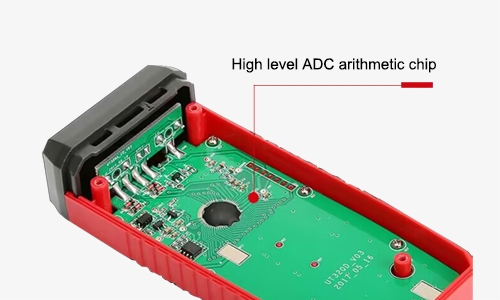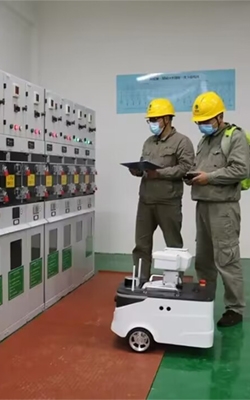SISCO's newly upgraded advanced touchless infrared thermometer can obtain the surface temperature of objects in a non-contact manner, allowing users to quickly and easily measure the temperature of hard-to-reach areas.

High-Efficiency Temperature Measurement
- Uses dual-wavelength rotatable laser indicators.
- MAX/AVG/DIF/MIN: Quickly displays maximum, minimum, average, and the difference between maximum and minimum values.

EBTN LED Display
- LED Backlit Display: Large screen with bold fonts and uniform white backlighting for clearer, brighter display.
- Equipped with an EBTN display screen, the negative display mode reduces glare, ensuring clear and easy-to-read text. It is more visible in sunlight and outdoor environments.

High-bit ADC Operation Chip
- Sampling, amplifying and AD conversion of thermocouple temperature and voltage signals.
- Ensuring stable and accurate temperature measurement in the industrial field, daily life or laboratory.
Applications
The advanced and professional ir non-contact thermometer from SISCO features fast response speed, high accuracy, and strong sensitivity. It is an essential tool for engineers and technicians in various fields, including power distribution inspection, HVAC maintenance, transportation equipment inspection, and equipment repair. These attributes make it indispensable for professionals dedicated to maintaining and optimizing technical systems, ensuring safety, efficiency, and reliability in their operations.

HVAC Maintenance

Traffic Facility Inspection

Equipment Repair

Power Distribution Inspection
| Model | 309A | 309C | 309D | 309E |
| Measurement Range | -35°C~450°C (-31°F~842°F) | -35°C~650°C (-31°F~1202°F) | -35°C~850°C (-31°F~1562°F) | |
| Measurement Accuracy | ≥0℃:±1.8°C or ±1.8%, ≤0℃:± (1.8°C + 0.1°C / °C) |
>0°C: ±1.8°C or ±1.8%, <0°C: (1.8°C + 0.1°C / °C) |
≥0℃: ±1.8°C or ±1.8 %, <0℃:±1.8°C or ±1.8 % |
|
| ≥32°F: ±3.6°F or ±1.8%, ≤32°F℃: ± (±3.6°F + 0.2°F/°F) |
>32°F°C: ±3.6 or ±1.8%, <32°F: (3.6°F+0.1°F/°F) |
≥32°F: ±3.6°F or ±1.8%, ≤32°F℃: ± (±3.6°F + 0.2°F/°F) |
||
| Optical Resolution | 10:1 | 12:1 (calculated when energy is 90%) | 20:1 | |
| Emissivity | 0.95 | 0.1~1.0 adjustable | ||
| Response Time | 250ms (95% of reading) | |||
| Display Resolution | 0.1°C (0.1°F) | |||
| Repeatability | ±1.0°C (1.8°F) or ±0.8% | ±1.0°C (2°F) or ±1% | / | |
| LED Alarm | √ | |||
| Number of Lasers | Single laser | Dual Laser | ||
| Laser Type | CLASS II | |||
| Laser Wavelength | 630nm~670nm | |||
| Laser Power | <1mW | |||
| Battery Type | 9V battery (6F22) | |||
| Battery Life | >10H (continuous operation when laser backlight is turned on) | |||
| Size | 189mm*118mm*55mm | |||
| Weight | 292g | |||
| Operating Temperature | 0°C~50°C (32°F~104°F) | |||
| Storage Temperature | -20°C~60°C (-4°F~140°F) | |||
| Working Humidity | <90% (non-condensing) | |||
| Operating Altitude | 2000m | |||
| Storage Altitude | 12000m | |||
| Protection Level | According to IEC60529, IP65 | |||
| Drop Test | 3m | |||
Details

Q1: What are some applications of infrared thermometer in industry?
A1: Infrared thermometers find numerous applications across various industries due to their non-contact nature, speed, and accuracy. Some common industrial applications include: manufacturing, HVAC(Heating, Ventilation, and Air Conditioning), electrical maintenance, food processing, metallurgy, automotive, building inspection, firefighting etc.
Q2: How do you store an infrared thermometer?
A2: When storing your infrared thermometer, choose a clean, dry spot away from extreme temperatures. Keep it protected in its case to prevent dust buildup and damage. Regularly check for signs of wear or damage to maintain its accuracy.
Q3: How far away should you hold an infrared thermometer?
A3: The distance at which you should hold an infrared thermometer depends on its spot ratio, which is the ratio of the distance from the thermometer to the object being measured to the diameter of the measurement area. Typically, the manufacturer specifies the spot ratio for the thermometer. As a general guideline, hold the thermometer at a distance that ensures the measurement spot covers the entire target area, ensuring accurate readings.
Tips: How does a infrared thermometer work?
An infrared thermometer works by detecting infrared radiation, a type of electromagnetic radiation that objects emit as a function of their temperature. Here’s a step-by-step explanation of how it operates:
1. Emitted Infrared Radiation: All objects emit infrared radiation proportional to their temperature. The hotter the object, the more infrared radiation it emits.
2. Detection: The infrared thermometer has a lens that focuses this emitted infrared radiation onto a detector, typically a thermopile or pyroelectric sensor.
3. Conversion to Electrical Signal: The detector converts the infrared radiation into an electrical signal. The intensity of the radiation (which correlates with the temperature of the object) determines the strength of the electrical signal.
4. Signal Processing: The electrical signal is processed and converted into a temperature reading. The thermometer uses algorithms to account for emissivity (how effectively an object emits infrared radiation) and other factors to ensure accurate temperature measurement.
5. Display: The processed temperature reading is then displayed on the thermometer's screen, providing the user with the temperature of the target object.
In summary, an infrared thermometer measures the infrared radiation emitted by an object and converts it into an electrical signal, which is then processed and displayed as a temperature reading.
Thank you for buying industrial test and measurement equipment on SISCO.com, all products sold by SISCO and the partner cover a 12 months warranty, effective from the date of receiving the products.
What is covered?
SISCO is responsible for providing free spare parts, and free technical support to assist the customer to repair the defective products until the problem is solved.
What is not covered?
- Product purchased from anyone other than a SISCO store or a SISCO authorized reseller.
- Expendable parts.
- Routine cleaning or normal cosmetic and mechanical wear.
- Damage from misuse, abuse or neglect.
- Damage from use of parts other than SISCO approved.
- Damage from use outside the product’s usage or storage parameters.
- Damage from use of parts not sold by SISCO.
- Damage from modification or incorporation into other products.
- Damage from repair or replacement of warranted parts by a service provider other than a SISCO authorized service provider.
- Damage caused by the application environment not meeting the product usage requirements and the failure to perform preventive maintenance.

